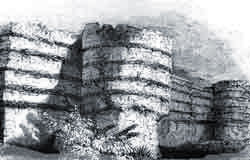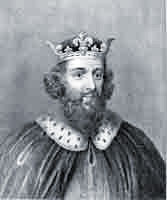History of Alfred the Great and the BurhsAlfred the Great and the Burhs - The Fall of the Romans & the rise of the Anglo Saxons
- What were the Burhs & the Burhs? How were they maintained?
- The history of King Alfred the Great
- What was the purpose of Burghal Hidage ?
What was the Meaning & Origins of the word 'Burhs' & Burghs?
King Alfred the great introduced a National Defence system by the formation of 'Burhs' or 'Burghs' the meaning of which meant "fortress" or castle. The meaning gradually changed from "fortress," to "fortified town," to simply "town". The word 'Burhs' later changed to Burgh, Bury then Borough which are evident in many modern British place names. Any such place name is an immediate indication that signifies that a Burh was once built in the area. The History of the Anglo Saxons
When the Romans left England the country was left to the English Celts. There was no one leader, or King. Law and civilisation broke down! The indigenous population of Southern England were the Celts. After the Romans left the land the English Celtic tribes were under attack form various forces - the Scots, the Welsh and then the Vikings! The Celts needed help and they arranged for foreign mercenaries from Europe to fight off these invaders. These foreign mercenaries were paid with land. The families of the mercenaries, many from Germany, also came to England. Theses German Mercenaries were called Saxons! The Saxons began taking over from the Celts, many of which were driven from the South England to the West and North of England. The Celts who remained integrated with the Saxons and the Anglo-Saxons were born - their land base was called Wessex. In 878 there was a massive attack by the Vikings - the King of Wessex at the time was called Alfred. King Alfred decided it was time to fight back and defend the land. Biography of King Alfred the Great - 849- 899
King Alfred is the only English King to be given the title 'the Great'. He became King in 871 at the age of twenty-one. Following his victory against the Vikings at the Battle of Ashdown in 871 King Alfred the Great of Wessex in England introduced a National Defence system against the Viking invaders by the formation of 'Burhs' and 'Burgh Castles'. He organised his army to serve on a rota basis which enabled his thegns and peasants to take turns between tending their farms and serving in the army. In May 878 from a fortified base, or Burgh Castle, at Athelney in the Somerset , Alfred's army finally defeated the Danes at the Battle of Edington. The Burhs of King Alfred the Great
The National Defence system of the Burhs was a brilliant idea. The Burhs ensured that all of King Alfred's subjects would be close to safety: None of Alfred's subjects would be more than 20 miles, or one day away, from a place of refuge! The 'Burhs' would house the people during enemy raids. Everyone took responsibility for building this system of defence. The 'Burhs', or fortified towns, were based and built on old Bronze Age and Roman fortifications and in important religious centers- these towns were usually near the coast, situated on high ground and surrounded by a wall and a ditch. Each man in the district was responsible for maintaining a section of the Burgh wall in exchange for a safe haven during enemy attacks. - The 'Burhs' were fortified towns
- Situated in strategic positions - hilltops, at river crossings or overlooking harbours
- The 'Burhs' would house the people during enemy raids
- None of King Alfred's subjects would be more than 20 miles, or one day away, from a place of refuge
- Many Burhs were built on old Bronze Age and Roman fortifications
- Other Burhs were built in important religious centres
- At Witham, in Essex, the remains of a Burh are still visible - it covers an area of twenty-six acres and was clearly built with a series of earthworks - mounds and ditches
- The first of these towns were usually near the coast - ready for any invaders - especially the Vikings
- Like the Hillforts and fortresses before them they were situated on high ground and surrounded by a wall and a ditch
- Each man in the district was responsible for maintaining a section of the Burgh wall in exchange for a safe haven during enemy attacks
- The maintenance obligation required careful recording in what became known as 'the Burghal Hidage'
- The Burghal Hidage gave details of the building and manning of the Burhs
- The size of the Burhs were recorded
- The length of their ramparts
- The number of men needed to garrison them
- The Vikings plans to invade Wessex were crushed
- The word 'Burhs' later changed to Burgh, Bury then Borough which are evident in many modern British place names
|


